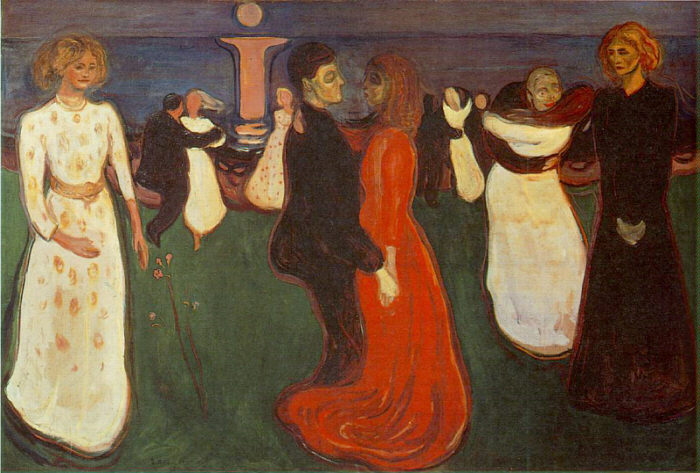He’s not German but he is the father of German Expressionism. He was considered mad, due to the popular belief that artistic talent was heightened by illness and despair, rather than the courage to look into the darkness that other men are too afraid to contemplate. Everyone knows his most famous angst painting, “The Scream” but it is not like his other works and it is not my favorite – “The Dance of life” is.
Here merrymakers party while they can, before the Nordic sun drowns them in a sea of darkness for six months, before death, a constant theme of Munch’s, crosses the grass to claim his victim. A ghostly quiet emanates from the painting, as if someone has turned the volume off.
In case you don’t feel death, who seems to haunt our artist, Munch has put three women in the foreground representing the three stages of a woman’s life. Their close proximity emphasizes the shortness of that life. The two women on either end are not watching the couple dancing with jealousy because she has a partner and they don’t; they are not that realistic, nor are they painted realistically. They are symbols and their flattened, outlined, simplified figures are more powerful with this double meaning.
Entering on the left, is youth, a golden haired girl in her first spring frock. She waits hopefully to dance, practically dancing by herself as she smiles, her hands ready to embrace life, almost touching the flower that leans towards her as a fragile warning.
While the other men dance happily with girls in virginal white, the artist (a self portrait?) has the guts to dance with the central female who wears red, the color of emotion, drama, and blood. She is a woman at the height of her powers, a temptress. Even her hair is red. Oblivious to her surroundings, unable to think of anything but the man in her arms, she pulls him closer, hypnotizing him. They are in love and he looks miserable.
To the right is the older woman both these women will become. She can only watch, standing alone, her hands grabbing onto each other. Resigned, she wears black, knowing her time is over. Her stance is stiff and awkward. There is no place for her at this dance of life and she hovers on the fringe taking a last bitter look.
Perhaps I shouldn’t say bitter. Maybe she’s bored by the party she has attended all of her life and she is just waiting for death to be a gentleman and open the door so she can leave. But our artist has given her a sad and longing face so I must surmise that men, especially Munch, have a harder time with the closing of life, unless it is in some odiously glorious battle. Or perhaps in spite of his fear of the vampire woman, he cannot stand the thought of loosing her even to the grim reaper. Unlike his painting “Vampire”, these women are not culprits. Life is the enemy and you are struck by the coldness with which he consumes them, the tight bud of spring, the lush passionate bloom, and the falling petals of age, all gone within a flower’s death.
Artillery Magazine Vol 2 no. 6 July/August 2008
